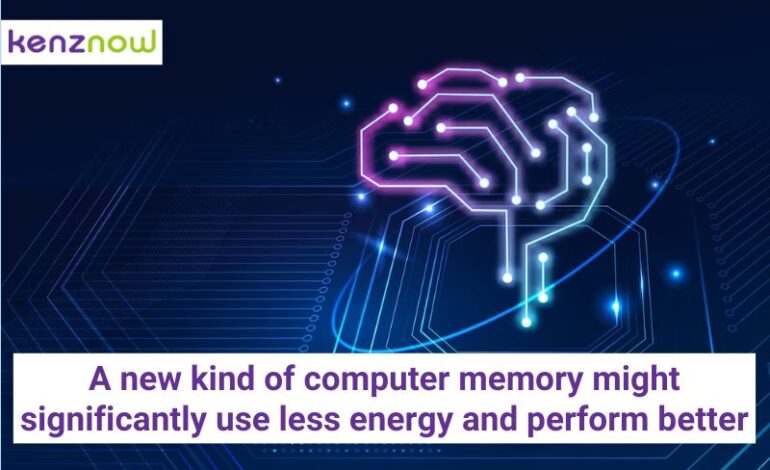A new kind of computer memory might significantly use less energy and perform better

प्रिय मित्रानो
शुभ प्रभात!
Welcome to Kenznow Newsletter
CAMPUS STORY
A new kind of computer memory might significantly use less energy and perform better
Source – University of Cambridge
The team of researchers, led by the University of Cambridge, created a tool that functions similarly to the synapses in the human brain in processing data. The technology is based on microscopic self-assembled barriers that can be raised or lowered to allow electrons to pass, as well as hafnium oxide, a substance that is already utilized in the semiconductor industry.
This technique could result in the development of computer memory devices with significantly higher density, higher performance, and lower energy consumption by allowing information processing and memory to coexist in the same space.
Because of our world’s endless desire for data, energy demands have exploded, making it harder than ever to cut carbon emissions. Over the next few years, it’s anticipated that internet usage, algorithms, artificial intelligence, and other data-driven technologies will use more than 30% of the world’s electricity.
First author Dr. Markus Hellenbrand, from Cambridge’s Department of Materials Science and Metallurgy, stated that the current computer memory technologies’ limitations are largely to blame for the growth in energy consumption. The process of moving data back and forth between memory and processing in conventional computing consumes both time and energy.
A new technology known as resistive switching memory is one potential answer to the issue of ineffective computer memory. The two possible states for conventional memory devices are one or zero. However, a working resistive switching memory device would have a wide range of states; computer memory devices based on this idea would be much faster and more dense.
Hellenbrand and his colleagues have created a new design for computer memory that might both significantly improve performance and lower energy requirements demanded by internet and communications technologies which are expected to use about a third of all the electricity produced in the world in the next 10 years.
HEARD ON WEB
The University Of Edinburgh Launches Hindi Course
The University of Edinburgh has teamed up with the Indian consulate in the UK to develop its first open-access course in the Hindi language. The Climate Solutions course has been curated with the aid of qualified translators and was a result of the government of India and the University’s Edinburgh collaboration.
The course is developed and delivered by award-winning climate change specialists, including Professor Dave Reay, the Executive Director of the Edinburgh Climate Change Institute (ECCI).
According to a press release from Edinburgh University, Climate Solutions: India (Hindi) examines the science, effects, and solutions of climate change in the nation. It is a useful resource for many thousands of Hindi-speaking students and educators throughout India and the rest of the world.
According to the University release, the added language makes the course more accessible and represents a significant turning point for the University Institute.
The five-week course focuses on the many climatic zones found in India as well as how shifting climate zones may affect the nation’s health, agriculture, and economy.
The course is also available in English and Arabic, and additional versions are soon to be introduced in Senegal, Malawi, Ecuador, and Mexico.
EDUCATION ABROAD
Massachusetts Institute of Technology
The Massachusetts Institute of Technology (MIT) is a prestigious private research university located in Cambridge, Massachusetts, United States. Established in 1861, MIT is known for its focus on scientific, engineering, and technological education and research. With a focus on innovation and entrepreneurship, MIT fosters a culture that encourages students to push boundaries and explore new frontiers. Its world-class faculty, state-of-the-art facilities, and extensive research initiatives have made significant contributions to various disciplines. From pioneering breakthroughs in artificial intelligence to advancements in renewable energy, MIT continues to be at the forefront of technological innovation, shaping the future and making a lasting impact on society.
TRIVIA
Know the Language
Marathi
Marathi is an Indo-Aryan language spoken predominantly in the Indian state of Maharashtra and neighboring regions. It is the official language of Maharashtra and is also widely spoken in Goa, Karnataka, Gujarat, and other parts of India. Marathi has a rich literary heritage, with a vast collection of poetry, prose, and theatrical works dating back centuries. It is a vibrant language that reflects the culture, history, and traditions of the Marathi-speaking people. Marathi has its own unique script, known as the Devanagari script, and is known for its melodic and expressive nature. It has a significant influence on various art forms, including music, dance, and theater. Marathi plays a crucial role in connecting people, preserving cultural identity, and promoting regional literature and arts.
Till next issue.
पुन्हा भेटू!
Team Kenznow



